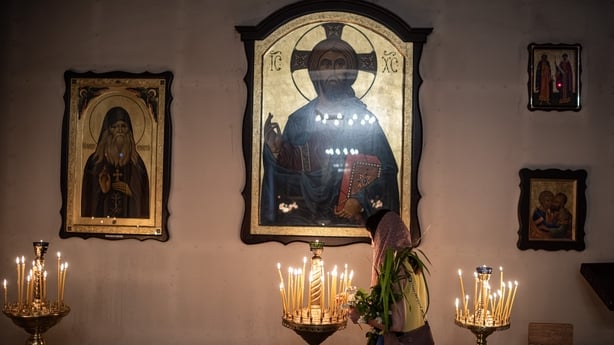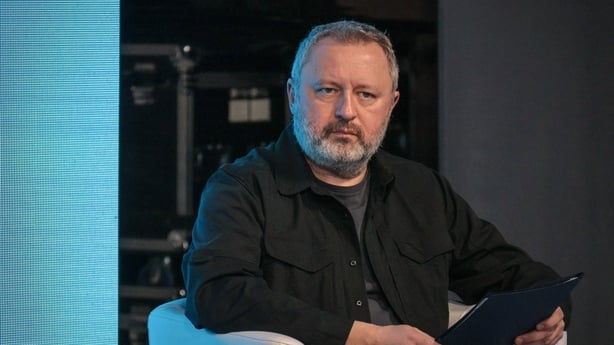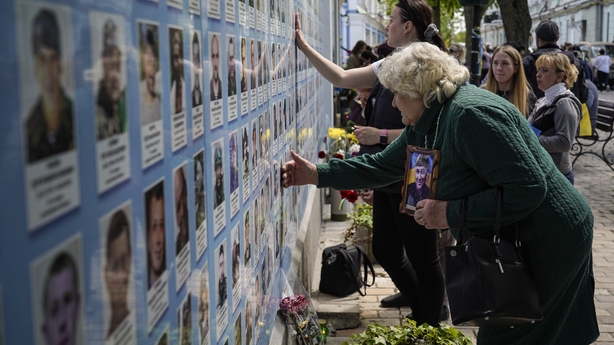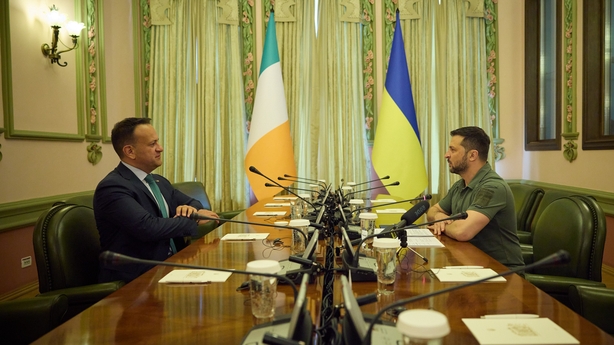Before the main event, his bilateral with Ukrainian President Volodymyr Zelensky, the Taoiseach was given a two hour whistle-stop tour of Kyiv's northern suburbs.
The aim was clear - to let him see, at first hand, the results of Russian aggression and how the Ukrainian people have been responding.
The first stop was Bucha’s pristine white St. Andrew the First-Called Orthodox Church, where a bleak photo exhibition is on display.
As the bodies of civilians were exhumed from mass graves at the back of the site last year, the photographers recorded the shocking detail.
The small hand of a dead child emerging through the mud... the red nail varnish still visible on a dead woman’s hand.

The General Prosecutor of Ukraine Andriy Kostin explained the context of the exhibition and how evidence about the crimes committed here is being collated. Rebuilding around Bucha has been rapid, so much so that many of the scars of war have already been erased.
Ten minutes later the cavalcade was racing through a forest to one of the key battle sites in the first days of the war. Moschun town, and the forest, is regarded as a place where Ukrainian forces held off a massive Russian advance which protected Kyiv at a critical stage in the invasion.
Described as one of the fiercest and most important battles, Ukrainian forces held out here despite being greatly outnumbered and pounded by artillery, mortar, suicide drones, and attack helicopters.
The site was quiet this morning, apart from birds chirping noisily in the trees as Mr Varadkar laid a wreath to the fallen defenders, photos of whom are displayed on tree trunks at the edge of the forest.
The third site we were taken to was close to Irpin, another northern suburb where Irish journalist Pierre Zakrzewski was killed, along with his UKrainian translator, Oleksandra Kuvshynova. They were part of a Fox News team which came under attack crossing a checkpoint.

To understand the impact on the civilian population Mr Varadkar next visited a residential district called Horenka which had been shelled by artillery rounds and also hit by aerial bombardment. It's unclear which of these was responsible for gutting the residential apartment block we visited but the translator thought it most likely to have been a bomb dropped by a Russian warplane.
On one interior wall of the damaged building is a Banksy mural.
It features a non-plussed bearded man taking a bath and nonchalantly scrubbing his back - a nod to the local population who refused to be cowed by Russian aggression.
The final stop before meeting the President was the now notorious Romanivsky bridge. Stretching over the Bucha river it became a flashpoint in the conflict as civilians attempted to flee Irpin for Kyiv. Branded a 'vehicle graveyard’, countless civilian cars were shot up by Russian forces.
The bridge was ultimately blown up by the Ukrainian army to protect the capital from the lengthy Russian convoy which had crossed into Ukraine from Belarus.

Possibly the most moving moment was at another site familiar to us from news reports - the Wall of Remembrance of the Fallen - a wall below the golden-domed St Michael’s Church in Kyiv. Decorated with thousands of photographs of Ukrainian soldiers who have been killed.
So many young faces, and a question hanging in the air - how many more faces will be mounted on that memorial before the war is ended.
We were shown to the Presidential press room where the media waits, while the two leaders held their bilateral meeting- a room now instantly recognisable from daily conferences and visits by world leaders.
Three flags, today including the Irish tricolour; two podiums, the Taoiseach standing on the left.

President Zelensky spoke first - saying he was "very grateful" that Mr Varadkar had travelled to the massacre site at Bucha before their bilateral meeting, as the Taoiseach now "seen with his own eyes" the consequences of Russian terrorism.
He said that there "had to be accountability" for Russian perpetrators of war crimes, something the Taoiseach agreed with - saying he’d been "face to face with the horror" of Russian actions.
Both leaders also agreed on Ukraine’s accession to the European Union. The Ukrainian President said it was "important" that these talks commence this year, with Mr Varadkar adding: "If you need any help, you only have to ask."
Ireland’s neutrality did come-up, despite the Taoiseach saying while Ireland was militarily neutral it wasn’t politically neutral. The President said he had understood Ireland’s position.
However, when pressed on this stance by a journalist from Ukrainian TV, Mr Varadkar replied that Ireland had "no intention" of joining NATO but would continue to supply practical and financial support - for example, training Ukrainian forces in demining techniques and battlefield medicine.
The two leaders retired for lunch as the media pack made the usual dash to get their stories published - for security reasons, a strict media blackout was in place until the event had ended.
On the streets of Kyiv, daily life looks almost normal. The heatwave sweeping Europe is evident here too as city-dwellers sit outside cafés dressed in shorts and t-shirts.
But there had been air raid alerts overnight in the capital, and the southern port city of Odesa was bombed.
And that’s what’s deceptive about this long running conflict - at any moment a rocket attack can hit, bringing with it more death and more misery.
Read more:
Taoiseach pledges support during surprise Kyiv visit
Russia says cargo ships are potential military targets
Varadkar meets Ukrainian actor attacked in Dublin






